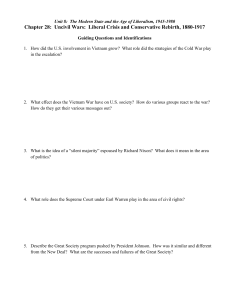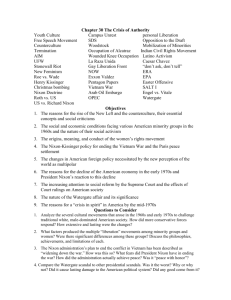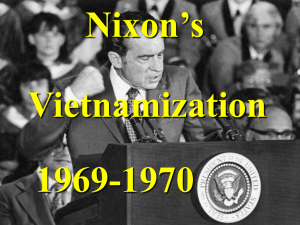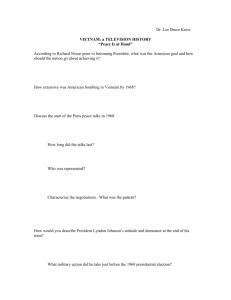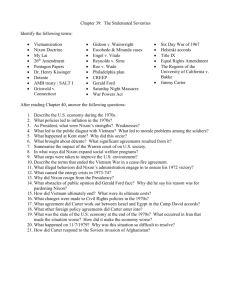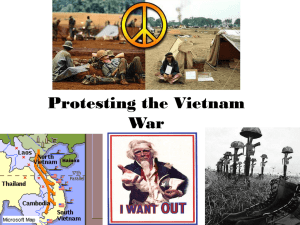Richard Nixon and the ending of Vietnam
advertisement
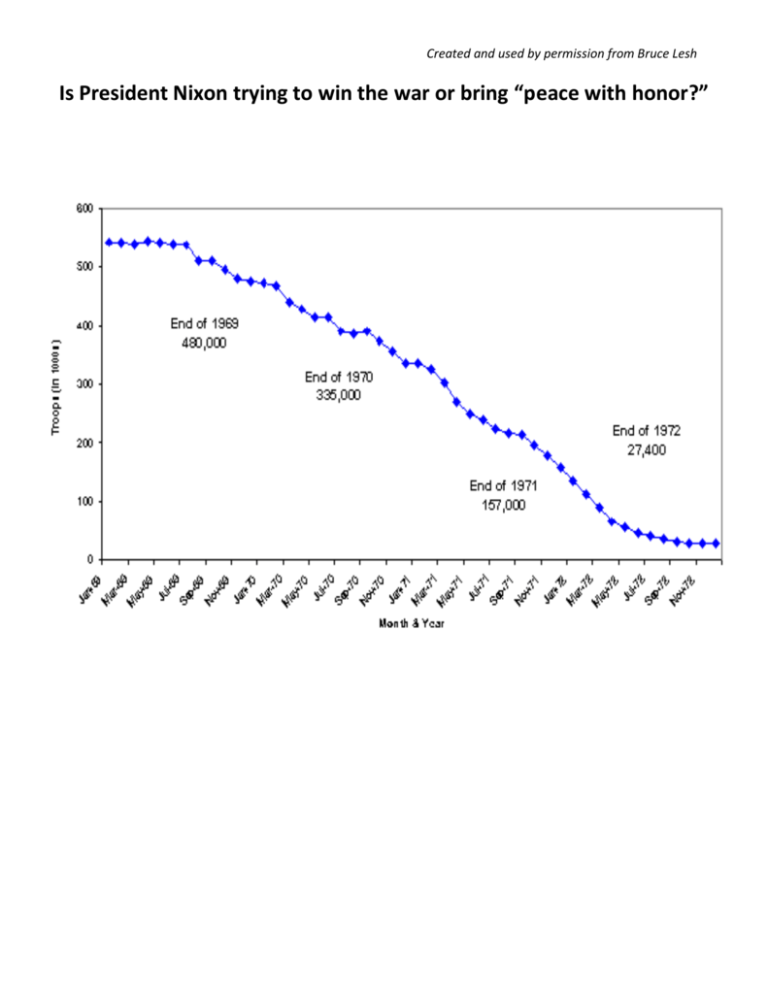
Created and used by permission from Bruce Lesh Is President Nixon trying to win the war or bring “peace with honor?” Created and used by permission from Bruce Lesh American Actions in: 1969 • Secret Bombing of Cambodian portion of the Ho Chi Minh Trail • Vietnamization Policy announced American Actions in: 1970 • Secret peace talks begin between the US and North Vietnam • President Nixon orders an invasion of Cambodian portion of the Ho Chi Minh Trail American Actions in: 1971 • President Nixon visits Communist China to put pressure on the Soviet Union and North Vietnam to negotiate Created and used by permission from Bruce Lesh Withdrawal of U.S. troops will become like salted peanuts to the American public...” Nixon and Vietnam Read the following and: 1. Circle information that helps you to understand the context (time period the source was created). 2. Underline information that helps you to understand the subtext (information about the author/author’s purpose for creating the source) 3. Take notes (to the left of the source) on what the source indicates regarding President Nixon’s intentions in Vietnam. Source 1: Address to the Nation on the Situation in Southeast Asia, President Nixon, November 3, 1969 Background Information: President Richard M. Nixon delivered, via television this address that is often referred to as the “Silent Majority” Speech, for near its end he appealed for support from “the great silent majority of my fellow Americans”—that is, those who supported his policies but did not speak up. Nixon was contrasting these mainstream Americans with vocal opponents of his policies who protested and demonstrated against the war in October of 1969. Good evening, my fellow Americans: Tonight I want to talk to you on…the war in Vietnam. The great question is: How can we win America's peace? In order to end a war fought on many fronts, I initiated a pursuit for peace on many fronts. We have offered the complete withdrawal of all outside forces within 1 year. We have proposed a cease-fire under international supervision. We have offered free elections under international supervision with the Communists participating in the organization and conduct of the elections… We have not put forth our proposals on a take-it-or-leave-it basis. We have indicated that we are willing to discuss the proposals that have been put forth by the other side. We have declared that anything is negotiable except the right of the people of South Vietnam to determine their own future. At the Paris peace conference, Ambassador Lodge has demonstrated our flexibility and good faith in 40 public meetings. Hanoi has refused even to discuss our proposals. They demand our unconditional acceptance of their terms, which are that we withdraw all American forces immediately and unconditionally and that we overthrow the Government of South Vietnam as we leave. …It has become clear that the obstacle in negotiating an end to the war is not the President of the United States. It is not the South Vietnamese Government. The obstacle is the other side's absolute refusal to show the least willingness to join us in seeking a just peace. And it will not do so while it is convinced that all it has to do is to wait for our next concession, and our next concession after that one, until it gets everything it wants. There can now be no longer any question that progress in negotiation depends only on Hanoi's deciding to negotiate, to negotiate seriously. At the time we launched our search for peace I recognized we might not succeed in bringing an end to the war through negotiation. I, therefore, put into effect another plan to bring peace--a plan which will bring the war to an end regardless of what happens on the negotiating front. The Vietnamization plan was launched following Secretary Laird's visit to Vietnam in March. Under the plan, I ordered first a substantial increase in the training and equipment of South Vietnamese forces…Under the new orders, the primary mission of our troops is to enable the South Vietnamese forces to assume the full responsibility for the security of South Vietnam. And now we have begun to see the results of this long overdue change in American policy in Vietnam. After 5 years of Americans going into Vietnam, we are finally bringing American men home. By December 15, over 60,000 men will have been withdrawn from South Vietnam including 20 percent of all of our combat forces. The South Vietnamese have continued to gain in strength. As a result they have been able to take over combat responsibilities from our American troops. Most important--United States casualties have declined during the last 2 months to the lowest point in 3 years. We have adopted a plan which we have worked out in cooperation with the South Vietnamese for the complete withdrawal of all U.S. combat ground forces, and their replacement by South Vietnamese forces on an orderly scheduled timetable. This withdrawal will be made from strength and not from weakness. Created and used by permission from Bruce Lesh Source Source 1: Address to the Nation on the Situation in Southeast Asia, President Nixon, November 3, 1969 Source 2: Address to the Nation on the Situation in Southeast Asia, President Nixon, April 30, 1970 Source 3: Political Cartoons A. Now, As I was saying four years ago! B. Fourth Year Of the “Plan To End The War” Source 4: December 9, 1970 8:45 PM: Two taped conversation in the White House between President Nixon and Secretary of State Henry Kissinger. Source 5: May 1972: In three top-secret eyesonly memos to Mr. Kissinger from President Nixon. Impact of Subtext and/or Context Win the War or Peaceful End and Why Created and used by permission from Bruce Lesh “Withdrawal of U.S. troops will become like salted peanuts to the American public...” Nixon and Vietnam Read the following and: 1. Circle information that helps you to understand the context (time period the source was created). 2. Underline information that helps you to understand the subtext (information about the author/author’s purpose for creating the source) 3. Take notes (to the left of the source) on what the source indicates regarding President Nixon’s intentions in Vietnam. Source 2: Address to the Nation on the Situation in Southeast Asia, President Nixon, April 30, 1970 Background Information: By April of 1970, 77% of Americans polled approved of how Nixon was handling the situation in Vietnam and only 6% disapproved. Although Nixon had increased his personal support, other indicators suggested that the public remained divided on policy in Vietnam. 55% of public now classified themselves as "doves" with only 31% using the "hawk" label. In April 1970, President Nixon in a televised speech to the American public defended his decision to send U.S. troops into Cambodia, an action that would widen the war. Good evening my fellow Americans: Ten days ago…I announced a decision to withdraw an additional 150,000 Americans from Vietnam over the next year. At that time, I warned that if I concluded that increased enemy activity in any of these areas endangered the lives of Americans remaining in Vietnam, I would not hesitate to take strong and effective measures to deal with that situation. Despite that warning, North Vietnam has increased its military aggression in all these areas, and particularly in Cambodia. …I have concluded that the actions of the enemy in the last 10 days clearly endanger the lives of Americans who are in Vietnam now and would constitute an unacceptable risk to those who will be there after withdrawal of another 150,000. To protect our men who are in Vietnam and to guarantee the continued success of our withdrawal and Vietnamization programs, I have concluded that the time has come for action. ...For the past 5 years…North Vietnam has occupied military sanctuaries all along the Cambodian frontier with South Vietnam. Some of these extend up to 20 miles into Cambodia…They are used for hit and run attacks on American and South Vietnamese forces in South Vietnam. These Communist occupied territories contain major base camps, training sites, logistics facilities, weapons and ammunition factories, airstrips, and prisoner-of-war compounds...In cooperation with the armed forces of South Vietnam, attacks are being launched this week to clean out major enemy sanctuaries on the Cambodian-Vietnam border....This is not an invasion of Cambodia…Our purpose is not to occupy the areas. Once enemy forces are driven out of these sanctuaries and once their military supplies are destroyed, we will withdraw. ...Now let me give you the reasons for my decision. A majority of the American people…are for the withdrawal of our forces from Vietnam. The action I have taken tonight is indispensable for the continuing success of that withdrawal program. A majority of the American people want to end this war rather than to have it drag on interminably. The action I have taken tonight will serve that purpose. A majority of the American people want to keep the casualties of our brave men in Vietnam at an absolute minimum. The action I take tonight is essential if we are to accomplish that goal. We take this action not for the purpose of expanding the war into Cambodia but for the purpose of ending the war in Vietnam and winning the just peace we all desire. We have made - we will continue to make every possible effort to end this war through negotiation at the conference table rather than through more fighting on the battlefield. During my campaign for the Presidency, I pledged to bring Americans home from Vietnam. They are coming home. I promised to end this war. I shall keep that promise. I promised to win a just peace. I shall keep that promise. We shall avoid a wider war. But we are also determined to put an end to this war. Created and used by permission from Bruce Lesh Source Source 1: Address to the Nation on the Situation in Southeast Asia, President Nixon, November 3, 1969 Source 2: Address to the Nation on the Situation in Southeast Asia, President Nixon, April 30, 1970 Source 3: Political Cartoons A. Now, As I was saying four years ago! B. Fourth Year Of the “Plan To End The War” Source 4: December 9, 1970 8:45 PM: Two taped conversation in the White House between President Nixon and Secretary of State Henry Kissinger. Source 5: May 1972: In three top-secret eyesonly memos to Mr. Kissinger from President Nixon. Impact of Subtext and/or Context Win the War or Peaceful End and Why Created and used by permission from Bruce Lesh “Withdrawal of U.S. troops will become like salted peanuts to the American public...” Nixon and Vietnam Read the following and: 1. Circle information that helps you to understand the context (time period the source was created). 2. Underline information that helps you to understand the subtext (information about the author/author’s purpose for creating the source) 3. Take notes (to the left of the source) on what the source indicates regarding President Nixon’s intentions in Vietnam. Source #3: Political Cartoons Background Information: Cartoonist Herb Block, a longtime cartoonist for the Washington Post was a dedicated political opponent of Nixon since 1950. He first attacked Nixon when he was in the United States Congress and charged him with exploiting fears of Communism for his own political advantage. Block continued his attacks throughout Nixon’s terms as Vice President and into his presidency. “Now, As I was saying four years ago!” Fourth Year Of the “Plan To End The War” (Contd.) Created and used by permission from Bruce Lesh Source Source 1: Address to the Nation on the Situation in Southeast Asia, President Nixon, November 3, 1969 Source 2: Address to the Nation on the Situation in Southeast Asia, President Nixon, April 30, 1970 Source 3: Political Cartoons A. Now, As I was saying four years ago! B. Fourth Year Of the “Plan To End The War” Source 4: December 9, 1970 8:45 PM: Two taped conversation in the White House between President Nixon and Secretary of State Henry Kissinger. Source 5: May 1972: In three top-secret eyesonly memos to Mr. Kissinger from President Nixon. Impact of Subtext and/or Context Win the War or Peaceful End and Why Created and used by permission from Bruce Lesh “Withdrawal of U.S. troops will become like salted peanuts to the American public...” Nixon and Vietnam Read the following and: 1. Circle information that helps you to understand the context (time period the source was created). 2. Underline information that helps you to understand the subtext (information about the author/author’s purpose for creating the source) 3. Take notes (to the left of the source) on what the source indicates regarding President Nixon’s intentions in Vietnam. Source 4: December 9, 1970 8:45 PM and December 9, 1970 8:45 PM: Taped conversations in the White House between President Nixon and Secretary of State Henry Kissinger. Background Information: President Nixon, just like the five presidents before him, taped all of the conversations that occurred in the Oval Office and over the telephone. The following are transcriptions of telephone conversations and Top-Secret memos between President Nixon and his Secretary of State Henry Kissinger. All of the words are from President Nixon. December 9, 1970 8:45 PM: Taped conversation in the White House between President Nixon and Secretary of State Henry Kissinger …They [the United States Air Force] have got to go in there [Cambodia] and I mean really go in. I don’t want gunships, I want helicopter ships. I want everything that can fly to go in there and crack the hell out of them. There is no limitation on mileage and there is no limitation on budget. Is that clear? …We are airlifting supplies [into Cambodia] and sure there are some troops but I don’t want numbers out [to the public or the press]. I don’t want anything like that. I don’t want the plan out and I don’t want the air force bragging about it and I don’t want a goddamn thing said [to the public or the press]. …I want them [the United States Air Force] to hit everything. I want them to use the big planes, the small planes, everything they can that will help out there [in Cambodia] and lets start giving them [the North Vietnamese] a little shock. …We have got to do a better job because we are just coming to the crunch. Right now there is a chance to win this goddamn war and that’s probably what we are going to have to do because we are not going to do anything at the conference table [during peace negotiations with North Vietnam]… March 11, 1971 taped Oval Office conversation between President Nixon and National Security Advisor Henry Kissinger. President Richard Nixon:…We know what these people [the South Vietnamese] can or can’t do…We’ve got to get the hell out of there. That’s for sure. National Security Advisor Henry Kissinger: No Question. President: I’m not going to allow their weakness and their fear of the North Vietnamese to, to, to delay us…Now we’ve tried everything; we’ve done everything our military wants. We have, we’ve done everything to our own satisfaction in order to bring the war to a successful conclusion. I think, I think it’s going to work…I agree with you that there’s a 40 to 50 percent chance, maybe 55, that it will work, that we might even get an agreement [peace agreement with the North Vietnamese]…Of course there will still be war out there, back and forth, but the South Vietnamese are not going to be knocked over by the North Vietnamese---not easily, not easily.” Created and used by permission from Bruce Lesh Source Source 1: Address to the Nation on the Situation in Southeast Asia, President Nixon, November 3, 1969 Source 2: Address to the Nation on the Situation in Southeast Asia, President Nixon, April 30, 1970 Source 3: Political Cartoons A. Now, As I was saying four years ago! B. Fourth Year Of the “Plan To End The War” Source 4: December 9, 1970 8:45 PM: Two taped conversation in the White House between President Nixon and Secretary of State Henry Kissinger. Source 5: May 1972: In three top-secret eyesonly memos to Mr. Kissinger from President Nixon. Impact of Subtext and/or Context Win the War or Peaceful End and Why Created and used by permission from Bruce Lesh “Withdrawal of U.S. troops will become like salted peanuts to the American public...” Nixon and Vietnam Read the following and: 1. Circle information that helps you to understand the context (time period the source was created). 2. Underline information that helps you to understand the subtext (information about the author/author’s purpose for creating the source) 3. Take notes (to the left of the source) on what the source indicates regarding President Nixon’s intentions in Vietnam. Source 5: May 1972: In three top-secret eyes-only memos to Mr. Kissinger, President Nixon explains his thinking behind escalating the bombing and mining of North Vietnam's harbors. Background Information: President Nixon, just like the five presidents before him, taped all of the conversations that occurred in the Oval Office and over the telephone. The following are transcriptions of telephone conversations and Top-Secret memos between President Nixon and his Secretary of State Henry Kissinger. May 4, 1972. Taped Oval Office Conversation between President Nixon, National Security Advisor Henry Kissinger, and two White House aides. Conducted just prior to the secret mining of Haiphong Harbor in North Vietnam. As heard on the tape, the President thumped his desk as he pointed to an imaginary—or perhaps real—map: President Nixon: Vietnam: Here’s those little &^%$@#**ers right in there, here they are (thump). Here’s the United States (thump)…Here we are. They’re [The North Vietnamese] taking on the United States. Now goddamnit, we’re gonna do it. We’re going to cream them. This is not in anger or anything…I should have done it long ago, I just didn’t follow my instincts. …I’ll see that the United States does not lose. I’m putting it quite bluntly. I’ll be quite precise. South Vietnam may lose but the United States cannot lose. Which means, basically, I have made a decision. Whatever happens to South Vietnam, we are going to cream North Vietnam. … For once we’ve got to use the maximum power of this county…against this shitass little country [North Vietnam] to win the war. We can’t use the word “win” but others can.” May 9: You have often mentioned the necessity of creating the impression in the enemy's mind that I am absolutely determined to end the war and will take whatever steps are necessary to accomplish this goal. The time to take those steps is now. . . . I cannot emphasize too strongly that I have determined that we should go for broke. . . . Our greatest failure would be to do too little too late. [Called the madman scenario, it was devised for negotiating with the government of North Vietnam. In this gambit, Henry Kissinger would emphasize, in his meetings with representatives of North Vietnam, the volatility of President Nixon's personality. He would warn the North Vietnamese that Nixon was unpredictable, that he could fly into a rage, and that this could happen in response to either North Vietnamese military action or intransigence in the peace talks. A similar theme was sounded by Kissinger in his dealing with the American press.] May 10: On an urgent basis, I want the C.I.A. to implement . . . broadcasts, leaflets and every other device so that the North Vietnamese . . . are told of the massive public support for the president's decision . . . and any other story that might discourage the North Vietnamese leaders [from continuing to fight rather than negotiating a peace] Created and used by permission from Bruce Lesh Source Source 1: Address to the Nation on the Situation in Southeast Asia, President Nixon, November 3, 1969 Source 2: Address to the Nation on the Situation in Southeast Asia, President Nixon, April 30, 1970 Source 3: Political Cartoons A. Now, As I was saying four years ago! B. Fourth Year Of the “Plan To End The War” Source 4: December 9, 1970 8:45 PM: Two taped conversation in the White House between President Nixon and Secretary of State Henry Kissinger. Source 5: May 1972: In three top-secret eyesonly memos to Mr. Kissinger from President Nixon. Impact of Subtext and/or Context Win the War or Peaceful End and Why Created and used by permission from Bruce Lesh
